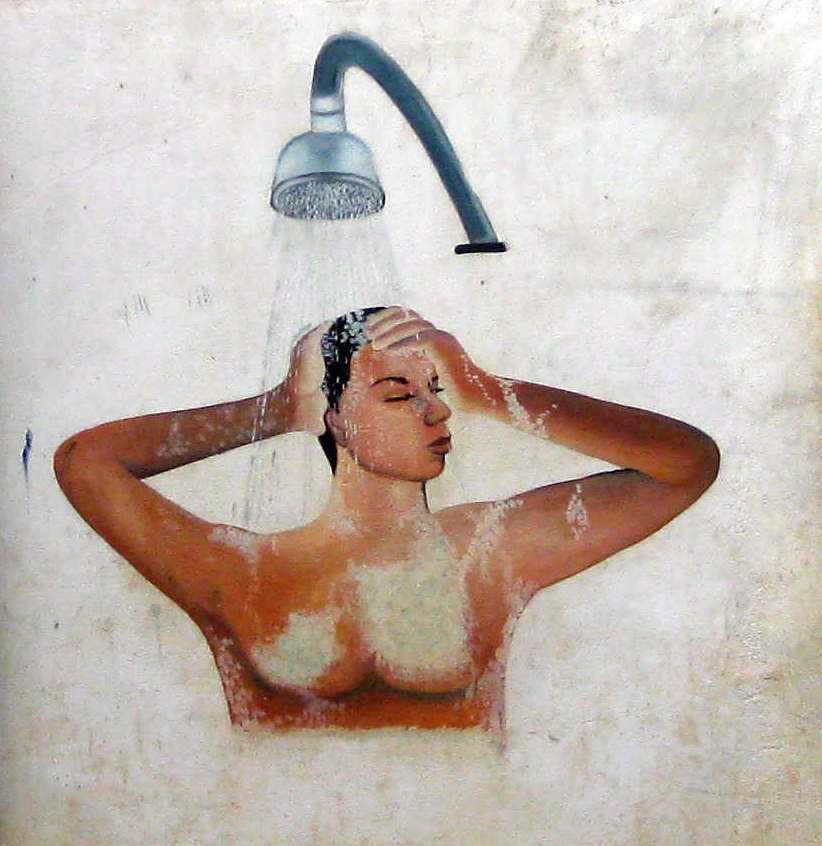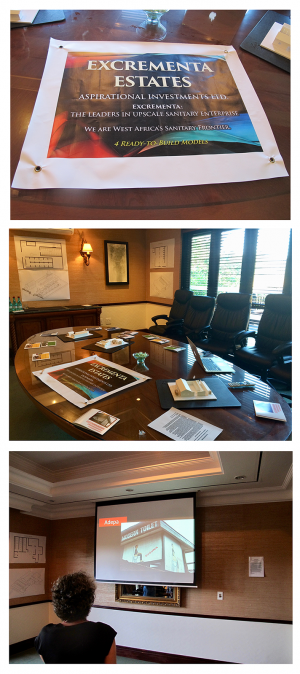[ Ed. note: This is the third of a three part collaboration on “Excrementa Estates.” Read parts I and II. ]
I
In July 2016, I was invited to a conference on technology in Durban, South Africa, held over several days at a tourist lodge turned meeting venue (Mellon Foundation 2016). Shunning the redundancy of read-out-loud conference papers and PowerPoints, conference organizers sought nontraditional presentations. Because the purpose of the gathering was to ask questions about the conventions and limits of technology and infrastructure studies in Africa, a contribution that was in some way concrete seemed appropriate. I was in the middle of a fellowship year devoted to turning my field research in Ghana on popular solutions to urban sanitation into a book. I was awash in words: transcripts from the field, journal articles, and the written and rewritten words of my manuscript. I welcomed the opportunity to work in a format where the tight textual conventions of anthropology could be sidelined.
In collaboration with Xhulio Binjaku, a student architect at the Massachusetts Institute of Technology (MIT), I created an installation of architectural models and real estate brochures featuring the public toilets I encountered in the course of field research in urban Ghana. I initially conceived the installation as a type of interdisciplinary play, putting anthropology into new conversations and materials. Play soon became provocation as I jumbled commercial stylistics with ethnographic analysis and the jest that inevitably accompanies popular treatment of fecal matters with a critique of expert-derived development prescriptions.
This special issue of Limn provides an opportunity to share and critically reflect on the Durban installation and the concerns and design processes behind it. What happens when a vernacular “fix” never intended for objectification becomes a model subject to replication and circulation? Can such ad hoc infrastructural solutions be turned into “development devices” amenable to abstraction and adaptation to other times and places? Could and should consumer and class-based desires be used to guide the making and marketing of such templates for development and design?
II

With the aid of this trove of images, from among the many possible points of entry into urban planning and public life in Tema, I chose to go underground and trace the forms and logics of sanitary infrastructure. The sanitary underground, what urbanist Lewis Mumford (1961) called the “invisible city,” was by all means a tangible, visceral component of urban experience in Tema, even if not fully knowable or entirely functional. Besides early sewerage plans, engineering specs, and logs of sewage volumes and system bottlenecks, there were complaint ledgers and tax schedules, and remnants of repair tenders and contracts.
Conducted over the course of a half-dozen visits to Ghana from 2010 to 2015, my fieldwork and archival studies showed a striking juxtaposition. Marking the aspirations of Ghana’s newly won national independence, Tema at its founding in the late 1950s embodied the sanitary standards of Euro-American high modernity (Harvey 2003; Melosi 2001). This included a citywide gravity-borne sewage system serving individual homes, each equipped with private water closets provisioned with identical imported fixtures. For more than 50 years, the original infrastructure remained in place. With heavy use, strained maintenance, and limited investment, the sanitary order I encountered a half-century later was in a state of grave disrepair. Reflecting Tema’s expanding population and footprint, urban residents from an array of occupations and class strata had devised a range of alternative approaches to large-scale human waste management across the city, supplementing and substituting for municipal provisioning (Chalfin 2014, 2017).
 Alongside the top-down schemes of mid-century urban planners and civil engineers, I found bottom-up solutions relying on diverse technologies, layouts, and fee structures, catering to different neighborhoods and constituencies (Chalfin 2014, 2017). Designed, built, and run by urban residents, these “popular infrastructures” operate largely outside the regulatory grasp of municipal authorities despite their value to a broad swath of urban dwellers. Some of the most intriguing sanitary arrangements I came across were located in Tema’s sister city of Ashaiman. Settled in the late 1950s to house casual laborers essential to the construction and operation of Tema’s port and industrial core, Ashaiman quickly became a commercial hub and migrant catchment area in its own right (Amarteifio et al. 1966). Though under the auspices of Tema’s municipal authority until 2008, investment in basic public services in Ashaiman was minimal, sanitation, sewerage, and public toilets included. As a consequence, human waste management across Ashaiman was and remains largely a function of self-organization.
Alongside the top-down schemes of mid-century urban planners and civil engineers, I found bottom-up solutions relying on diverse technologies, layouts, and fee structures, catering to different neighborhoods and constituencies (Chalfin 2014, 2017). Designed, built, and run by urban residents, these “popular infrastructures” operate largely outside the regulatory grasp of municipal authorities despite their value to a broad swath of urban dwellers. Some of the most intriguing sanitary arrangements I came across were located in Tema’s sister city of Ashaiman. Settled in the late 1950s to house casual laborers essential to the construction and operation of Tema’s port and industrial core, Ashaiman quickly became a commercial hub and migrant catchment area in its own right (Amarteifio et al. 1966). Though under the auspices of Tema’s municipal authority until 2008, investment in basic public services in Ashaiman was minimal, sanitation, sewerage, and public toilets included. As a consequence, human waste management across Ashaiman was and remains largely a function of self-organization.
Providing a forceful example of what Graham and Marvin (2001) call “splintering urbanism,” distinguishing Ashaiman from other systems of sanitary self-provisioning, the city contains a vast array of what I label dwelling-based public toilets (DBPTs). These are not the conventional, standalone commercial toilets in places of public thoroughfare. Rather, as the accompanying models drawings and images demonstrate, the individuals who own and operate the toilets fully incorporate them into domestic and dwelling spaces despite the facilities’ considerable sizes, with 8 to 20 seats and numerous technical entailments from water cisterns to large underground sewage holding tanks and sometimes biogas hook-ups. Most significant, situated within private residences by choice, these public sanitation systems are widely available to an otherwise underserved urban populace for a small fee per visit. In the face of gaps and lapses in state services, the designers cum proprietors of these vernacular infrastructures turn them into means of respectability and bodily relief for their customers, and a source of profit and public recognition for themselves.
III
Taken as a “type” all its own, Ashaiman’s DBPTs offer a compelling alternative to both the modernist ideal of private toilets in private homes and the developmentalist reality of public toilets in public places for the unplumbed urban dweller. They equally depart from the emerging array of sanitary novelties devised by humanitarian donor designers, from the Without Water Closet and Urine Diversion Toilet to the neo-chamberpot Dignity Toilet or the biodegradable Eco-bag (Redfield and Robins 2016). Ashaiman’s DBPTs instead represent what might be called a “fourth way” that innovates the possibilities of public toilet facilities and extant sanitary technologies. Those who devise and use Ashaiman’s varied DBPTs, moreover, are unabashed in their embrace of conspicuous consumerism, status aspiration, and profit making. As lifestyle choices integral to the persons and communities the toilets serve, these DPBPTs mark a radical departure from the utilitarian aesthetics of humanitarian design as well as the private house–private toilet mantra of public health experts.
Selectively reassembled for this issue of Limn, Binjaku’s and my contribution to the Durban conference showcased these realities in a site-specific installation titled “Excrementa Estates.” It included three-dimensional architectural models, two-dimensional layouts and projections, and photograph-rich brochures detailing four of the more than 150 DBPTs currently in operation across Ashaiman. My foremost aim was to objectify what can be called “African solutions to African problems” by posing the promise of vernacular infrastructure for development design. With public health campaigns around the world driven by the United Nations Millennial Development Goals of eradicating open defecation (United Nations 2006), Ashaiman’s DBPTs suggest a viable alternative. In sync with the social mores, living conditions, and incomes of the urban underclass, they are marked by wide availability, easy access, and relative affordability.
Ashaiman’s DBPTs likewise represent a better option than the oft-noted ideal of home-based facilities exclusively for residential use. A bourgeois rendering of sanitary modernity not too different from that envisioned at Tema’s founding, the World Health Organization and the World Bank are still promoting this approach as the best sanitary model for the Global South (World Bank 2014). However, it has met with only limited success due to the difficulty and high upfront cost of installation across the vast number and variety of urban dwellings and the sheer impossibility of ensuring access for all. This is especially so in urban areas such as Ashaiman, where a large portion of the population is transient and permanent accommodation is never assured.
In the Durban installation, a slideshow juxtaposing Ashaiman’s present-day sanitary realities with the original plans for the city of Tema accompanied the models, pamphlets, and posters of Excrementa Estates. Also included were images taken from recent promotional material from a new class of upscale planned communities in Ghana. In these neoliberal “New Towns,” with names like Apollonia, Heaven’s Gate, and Mirage, the promise of class mobility and domestic status symbols are key selling points. Featured in Limn, these ideals are deliberately reiterated in the illustrated brochures of Excrementa Estates, formatted to resemble popular real estate offerings. Though the dust and disarray of the booklets’ snapshots of actual urban living contrast with the clean surfaces and air-brushed messaging of the real-life real estate marketing material, their impulse is largely the same. Affirming the project’s plausibility, the advertising banner I printed in Ghana for the Durban event, reading, “Excrementa Estates: West Africa’s Sanitary Frontier,” was not considered out of the ordinary by the graphic designer who assisted with production and layout.
Highlighting the capitalization of property rights across the continent, the Durban conference was held at a small conference center and lodge located within a sprawling golf resort and residential development in the lush hills on the city’s outskirts. In addition to accommodating meetings, the lodge hosted the resort’s real estate sales. Its reception area included a plush, catalog-laden showroom containing house plans, price charts, and maps of the development’s numerous subdivisions. Nearby, a modest meeting room was reserved for the installation. Stocked with drinks, snacks, pads, and pens, it was appointed with the same warm lighting and mahogany furniture as the showroom. Giving further credence to Excrementa Estates’ resemblance to an actual real estate showcase, the architectural models were placed on the glass-topped table surrounded by their associated brochures. The large-format floorplans of the four structures were posted on the textured beige walls. These design elements helped convey a more serious point: the prime proponents of DBPTs will likely be upwardly mobile peri-urbanites with capital to invest in lucrative home-based enterprises. Class driven and profit based, though Ashaiman’s DBPTs have the potential to raise the quality of life for the many, the installation seeks to make clear they cannot be separated from the economic success of the few.
Reiterated by the very context of display, instead of couching Ashaiman’s sanitary prototypes in the guise of philanthropic good works, the installation marked the shared late-capitalist context of urban real estate development and humanitarian interventions. Attuned to these realities, the models and motifs of Excrementa Estates deliberately challenge the ethos of abjection that informs mainstream humanitarian design. Garnering awards for merging artistry and instrumentality, there is no doubt that many of the humanitarian devices that have emerged from the expansion of the development industry are marked by considerable elegance reflective of the modernist aesthetic of functional efficiency (Bell and Wakeford 2008; Redfield 2012). Yet, focused on Agamben-esque (1998) “bare-life,” humanitarianism by definition shuns gaudy excess, making little allowance for the superfluities of humor and pleasure, and, most of all, waste. Countering these principles of parsimony, the installation’s imagery highlights built forms overflowing with life, registering desire, disgust, shame, and delight.
IV
As an exercise in the nascent field of design anthropology, an uneasy translation of disciplinary knowledge was required to put these elements in dialogue. There was the fundamental challenge of hands-on three-dimensional construction. I willingly outsourced the task to Xhulio Binjaku, an architecture student at MIT and a University of Florida graduate who was already knowledgeable about my research and well informed about architecture in Africa. As much an epistemological impasse as technical problem, the fact remained that model making is not part of the mainstream of cultural anthropology. Besides the well-known anthropological penchant for textuality and conventions of “writing culture” (Clifford and Marcus 2010), the very act of modeling—stripping a complex, historically determined form down to its bare essentials—is antithetical to anthropological investment in context and specificity. Whereas distillation of the core elements of a social formation for purposes of analysis and comparison is well accepted, reduction in the service of replication and transferability is not because it compromises the anthropological precepts of cultural relativism and historical specificity.
 My goal, however, was to have it both ways and leverage the aesthetic and analytic power of a miniaturized mobile model while staying true to critique and context. Harking back to Geertz’s (1973) classic distinction, there was the lure of bringing into conversations about human development in Africa not just “models for” derived from technical abstractions and ideal types with the Global North as reference point. Injecting “models of” drawn from on-the-ground conditions into the humanitarian mainstream, the design templates derived from Ashaiman provide an opportunity to see “the real” as more radical than purely imagined alternatives. The abstractions, amplifications, and erasures entailed by modeling also make it possible to put aside particularities of time and place to see infrastructural configurations as functional wholes beyond the cobbled-together attributes of individual parts, persons, and ad hoc uses and repairs. Though models by definition are simplifications, they privilege integrity over idiosyncrasy. In this way models can be powerful agents of legitimation as they call out singular solutions for recognition and contemplation and amplify their unique features and potential impacts by rendering them “legible.”
My goal, however, was to have it both ways and leverage the aesthetic and analytic power of a miniaturized mobile model while staying true to critique and context. Harking back to Geertz’s (1973) classic distinction, there was the lure of bringing into conversations about human development in Africa not just “models for” derived from technical abstractions and ideal types with the Global North as reference point. Injecting “models of” drawn from on-the-ground conditions into the humanitarian mainstream, the design templates derived from Ashaiman provide an opportunity to see “the real” as more radical than purely imagined alternatives. The abstractions, amplifications, and erasures entailed by modeling also make it possible to put aside particularities of time and place to see infrastructural configurations as functional wholes beyond the cobbled-together attributes of individual parts, persons, and ad hoc uses and repairs. Though models by definition are simplifications, they privilege integrity over idiosyncrasy. In this way models can be powerful agents of legitimation as they call out singular solutions for recognition and contemplation and amplify their unique features and potential impacts by rendering them “legible.”
Despite these attractions, ethical questions loom large. Who gets to model? Who has the skill and authority to make and circulate models? Who gets to claim that something is worth modeling? Even more consequential is the question of to whom the models belong: Are the models themselves a form of intellectual property, or do they encapsulate the intellectual investments that stand behind them? Are they attributable to a single, deliberate author, or are the origins much more diffuse? In the face of a rising market for workable, replicable, and adaptable humanitarian devices and interventions, these are real concerns. For the models presented here, at the very least, we seek acknowledgment of their multiple sources: location, owner-operator, ethnographer, photographer, model-maker.
Also looming is the question of the very propositions these models encode. Although Ashaiman’s DBPTs promote the satisfaction of basic bodily needs in the face of limited wealth and considerable government constraint, they differ substantially from the broader catalog of humanitarian solutions in terms of scale. As this issue of Limn well illustrates, humanitarian interventions increasingly center on the design and distribution of little devices. Along with the generic emergency tents and tarps, there is, however, a rising prevalence of prefabricated field hospitals and “out of the box” schoolrooms and feeding centers, with every element designed and detailed from top to bottom (UNICEF 2017). Between the penchant for “little” or “large,” capitalist “excess” or modernist “parsimony,” Excrementa Estates captures design possibilities that emerge through living.

